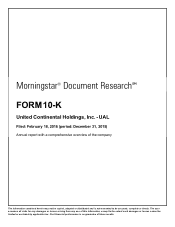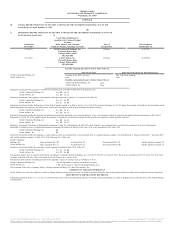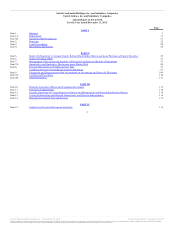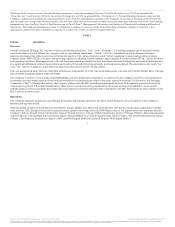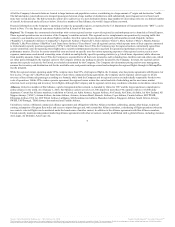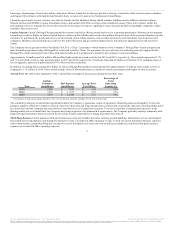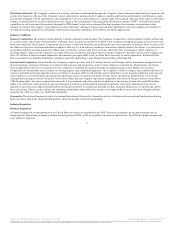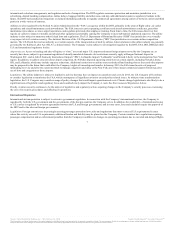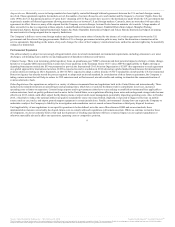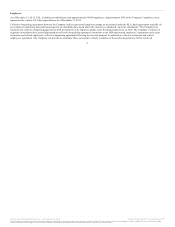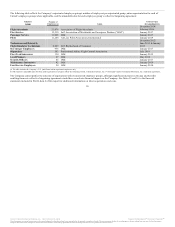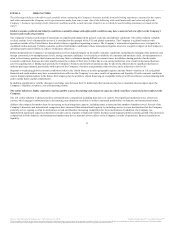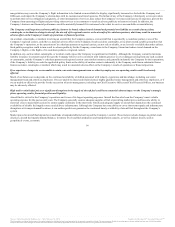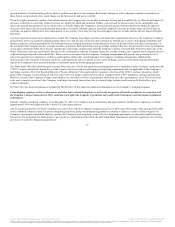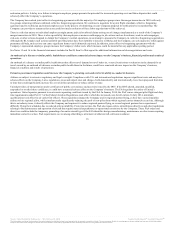United Airlines 2015 Annual Report Download - page 7
Download and view the complete annual report
Please find page 7 of the 2015 United Airlines annual report below. You can navigate through the pages in the report by either clicking on the pages listed below, or by using the keyword search tool below to find specific information within the annual report.
Distribution Channels. The Company’s airline seat inventory and fares are distributed through the Company’s direct channels, traditional travel agencies and
on-line travel agencies. The use of the Company’s direct sales website, united.com, the Company’s mobile applications and alternative distribution systems,
provides the Company with an opportunity to de-commoditize its services, better present its content, make more targeted offerings, better retain its customers,
enhance its brand and lower its ticket distribution costs. Agency sales are primarily sold using global distribution systems (“GDS”). United has developed
capabilities to sell certain ancillary products through the GDS channel to provide an enhanced buying experience for customers who purchase in that
channel. To increase the Company’s opportunities to sell its full range of products and services and lower distribution costs, the Company will continue to
develop new selling capabilities in third-party channels and expand the capabilities of its website and mobile applications.
Domestic Competition. The domestic airline industry is highly competitive and dynamic. The Company’s competitors consist primarily of other airlines and,
to a certain extent, other forms of transportation. Currently, any U.S. carrier deemed fit by the DOT is free to operate scheduled passenger service between any
two points within the United States. Competition can be direct, in the form of another carrier flying the exact non-stop route, or indirect, where a carrier serves
the same two cities non-stop from an alternative airport in that city or via an itinerary requiring a connection at another airport. Air carriers’ cost structures are
not uniform and there are numerous factors influencing cost structure. Carriers with lower costs may offer lower fares to passengers, which could have a
potential negative impact on the Company’s revenues. Decisions on domestic pricing are based on intense competitive pressure exerted on the Company by
other U.S. airlines. In order to remain competitive and maintain passenger traffic levels, we often find it necessary to match competitors’ discounted fares.
Since we compete in a dynamic marketplace, attempts to generate additional revenue through increased fares oftentimes fail.
International Competition. Internationally, the Company competes not only with U.S. airlines, but also with foreign carriers. International competition has
increased and may increase in the future as a result of airline mergers and acquisitions, joint ventures, alliances, restructurings, liberalization of aviation
bilateral agreements and new or increased service by competitors, including government subsidized competitors from certain Middle East countries.
Competition on international routes is subject to varying degrees of governmental regulation. The Company’s ability to compete successfully with non-U.S.
carriers on international routes depends in part on its ability to generate traffic to and from the entire United States via its integrated domestic route network
and its ability to overcome business and operational challenges across its network worldwide. Foreign carriers currently are prohibited by U.S. law from
carrying local passengers between two points in the United States and the Company experiences comparable restrictions in foreign countries except where
“fifth freedom rights” have been negotiated between the U.S. government and other countries. In addition, in the absence of open skies and fifth freedom
rights, U.S. carriers are constrained from carrying passengers to points beyond designated international gateway cities due to limitations in air service
agreements and restrictions imposed unilaterally by foreign governments. To compensate partially for these structural limitations, U.S. and foreign carriers
have entered into alliances, joint ventures and marketing arrangements that enable these carriers to exchange traffic between each other’s flights and route
networks. See above, for additional information.
Seasonality. The air travel business is subject to seasonal fluctuations. Historically, demand for air travel is higher in the second and third quarters, driving
higher revenues, than in the first and fourth quarters, which are periods of lower travel demand.
Domestic Regulation
All carriers engaged in air transportation in the United States are subject to regulation by the DOT. Absent an exemption, no air carrier may provide air
transportation of passengers or property without first being issued a DOT certificate of public convenience and necessity. The DOT also grants international
route authority, approves
6
Source: United Continental Holdings, Inc., 10-K, February 18, 2016 Powered by Morningstar® Document Research℠
The information contained herein may not be copied, adapted or distributed and is not warranted to be accurate, complete or timely. The user assumes all risks for any damages or losses arising from any use of this information,
except to the extent such damages or losses cannot be limited or excluded by applicable law. Past financial performance is no guarantee of future results.

